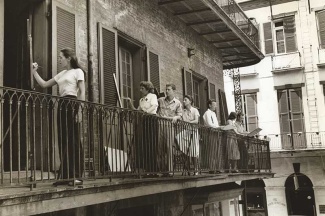Born in Acadiana on July 22, 1921, John Clemmer was a generously spirited luminary of the New Orleans art scene for seven-and-a-half decades. Between 1939 and 2014, he produced a substantial body of modernist art. Largely an abstract artist, he also executed portraits, landscapes and still lifes. A recent exhibition, John Clemmer: A Legacy in Art, debuted at The Historic New Orleans Collection on the centennial of his birth and featured 62 of the artist’s works, including paintings, drawings, prints and sculpture. A companion exhibition, Clemmer’s Circle: His Teachers, Students, and Colleagues, presented artworks by 76 artists he knew during his lengthy career. These included artists associated with the Arts and Crafts Club, the Orleans Gallery, Newcomb College, Tulane University, and the city at large.
John Clemmer: A Legacy in Art
A teacher of drawing and painting at the School of Architecture, chair of the Newcomb Art Department and producer of modernist art, the late John Clemmer is remembered for his generosity and impact on the New Orleans art scene.

Clemmer’s family relocated to New Orleans when he was 7 years of age. Throughout his four years at Fortier High School, he was enrolled in art classes, primarily freehand drawing with Josef Smith, and also took a course in mechanical drawing. After graduating in 1939, Clemmer attended the Arts and Crafts Club’s New Orleans School of Art on a scholarship. He studied in the French Quarter with the best-known artists of the day: Paul Ninas (1903–1964), Xavier Gonzalez (1898–1993), Enrique Alférez (1901–1999) and Julius Woeltz (1911–1956). Clemmer enjoyed long-standing friendships with these artists.
After his studies Clemmer served as a teacher at the school. Following two years of military service in World War II, in 1946 he became executive secretary of the club and director of its School of Art. He was the only person in the club’s history to have been a student, teacher and director of the club’s School of Art. The Arts and Crafts Club was the center of cultural life in the French Quarter from its incorporation in 1922 through the 1940s during which the city saw a flowering of the arts and literature; no comparable institution existed in the South. After students learned the basics of compositional design and craftsmanship, they were encouraged to explore artistic expression through non-traditional art movements.
This principle served Clemmer throughout his career. During his early years of development, he explored Cubism, the prevalent international art trend at the club. Clemmer retained line and geometry as structural elements for his work, but as his artworks matured, they were singular.
After students learned the basics of compositional design and craftsmanship, they were encouraged to explore artistic expression through non-traditional art movements.
Following the Arts and Crafts Gallery’s closing, Clemmer was invited to teach at Tulane University’s School of Architecture. From 1951 to 1978, he taught alongside artists who were associated with the Arts and Crafts Club, notably James Lamantia, Robert Helmer, Jack Hastings and Newton Howard — artists whose work was displayed in the Circle exhibition. Clemmer then chaired Newcomb’s Department of Art and was the first recipient of the Maxine and Ford Graham Chair of Fine Art. He retired as emeritus professor of art in 1986.
Throughout his career Clemmer immersed himself in creative reinterpretation of his subjects, which is most evident in his still lifes, each of which is radically different from the others. He maintained it was essential for artists to step away from a work and study the progress continuously. He adhered to the instruction of the club’s teachers, who advised students to reinterpret artworks creatively based on each individual’s perspective.
Clemmer traveled frequently and strove continuously to learn about art, art history and classical music. He was awarded a travel grant from the School of Architecture in 1962 to visit schools of architecture in Colombia, after which he began an eight-years series of abstract paintings and collages based on South America. He received another grant in 1967 to study form and color at Massachusetts Institute of Technology.
Kenneth Ducote (A&S ’71) remembered Clemmer’s tenacity in learning. “When I was a sophomore at Tulane, he was teaching in the architecture achool. I had General Biology 101 in one of the old-school amphitheater lecture rooms. Clemmer was auditing the class, sat in the front row, and diligently took notes. I always assumed that he was getting ideas about incorporating elements of nature in his designs.” He also audited a course in Early Christian and Byzantine manuscripts, which informed his paintings in his Topographia series. Each of the paintings in this series features a circle-within-a square, an inspiration of the Compass Rose seen on early navigational charts. After navigators learned the 32 navigational charts perfectly, it was called “Boxing the Wind.”
An exhibition catalogue was supported by the Tulane University School of Architecture’s John F. Clemmer Fund established by Martha Walters Barnett (NC ’69) and Richard R. Barton Jr. (A ’68). A wide-reaching exhibition, John Clemmer: A Legacy in Art covered much of the history of art in the city of New Orleans during the 75 years of Clemmer’scareer.
Judith H. Bonner earned a master’s degree from Tulane in 1983. She met John Clemmer while a graduate student in art history in the Newcomb Art Department, after which Clemmer invited Bonner to curate the Newcomb Centennial exhibition at the New Orleans Museum of Art. The author of several books on Southern art, Bonner came to The Historic New Orleans Collection in 1987 and is now Senior Curator and Curator of Art.






























































